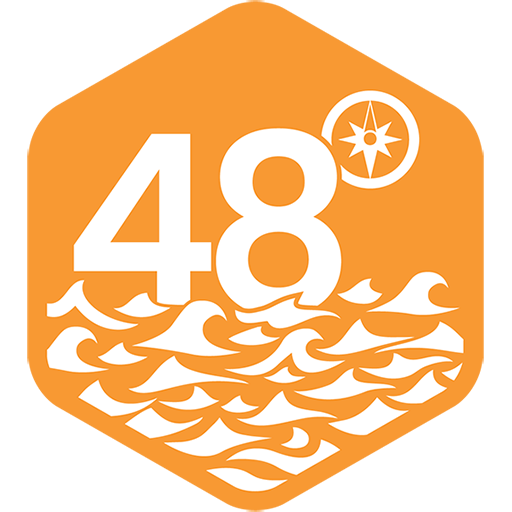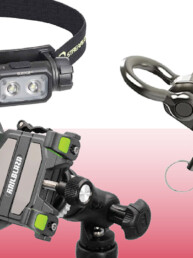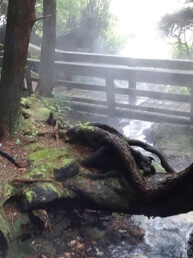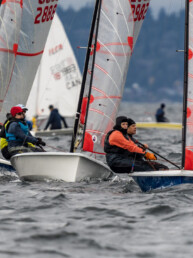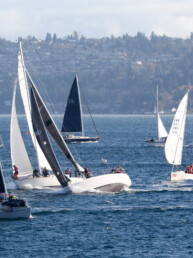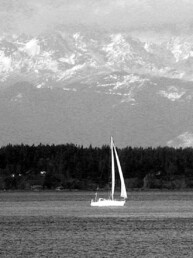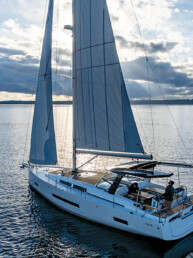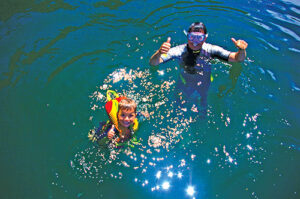
When my wife Jill and I moved to Seattle and bought our Grand Soleil 39, Yahtzee, the thought of swimming in the waters of the Salish Sea while cruising wasn’t even a blip on our radar. Our first taste of sailing together in the Pacific Northwest had come on a chilly and rainy early spring day, and we were making our best attempt to stay warm in newly-purchased foul weather gear with several layers underneath. It didn’t help that we’d come from the much warmer, tropical waters of Florida and the Caribbean, so our threshold for the cold wasn’t very robust.
“Swimming?” we thought. “In this water? No way.”
That all changed when our first summer arrived. By that time, we’d made friends with several of our neighboring liveaboards, many of whom insisted that we’d soon find our way into the water. We heard stories of warmer water in local bays from Puget Sound to the San Juan Islands and farther north in British Columbia, but I was skeptical. Fortunately, as the subsequent years of cruising in the Salish Sea and Alaska unfolded, it turned out they were right—especially after adding our two boys to the crew. As a family, we embraced swimming whenever we found the waters warm enough to take a dip, and in doing so, these moments became cherished memories in some of our favorite destinations. Most experienced Pacific Northwest cruisers will have their own list of saltwater swimming spots, and here are some of our family’s favorite Salish Sea and Inside Passage swimming locales.
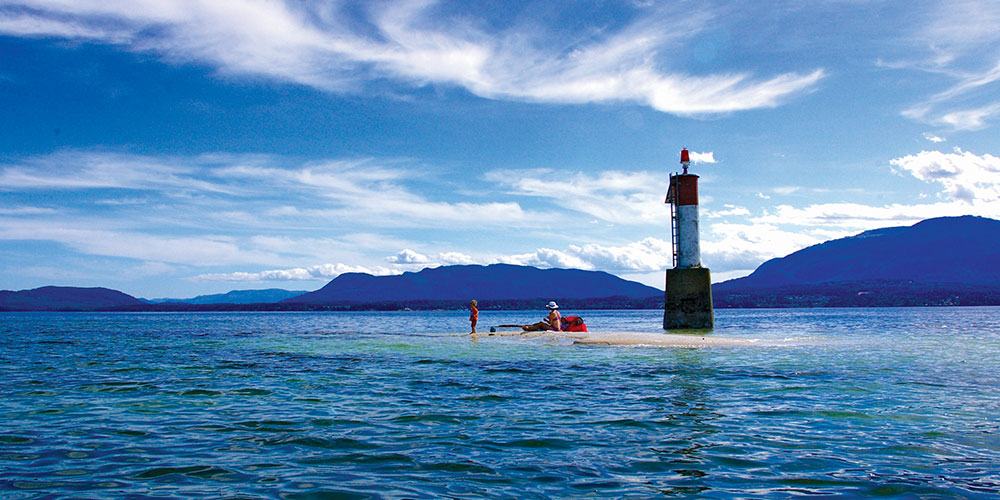
South Sound
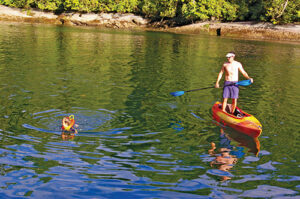
The first summer that we owned Yahtzee, we went on a 10-day cruise from Shilshole Bay down to the South Sound. Friends on the dock had told us that the South Sound was an ideal place to cut our teeth as new cruisers in the Pacific Northwest, even though it might lack wind. They said that it was far less crowded with boaters in the peak summer season than the San Juan and Gulf islands, and that there were lots of marine parks to explore. Also, we wouldn’t need to cross the Strait of Juan de Fuca or go up the Swinomish Channel to get there. We also learned that the waters of the South Sound can be warmer than their northern counterparts.
So it was, on a hot day in mid-July when we found our way into the water for our inaugural Puget Sound swim. We’d picked up a mooring buoy at McMicken Island Marine State Park that was too far from shore to have any shade cover. After a walk ashore, the heat of the afternoon began to warm the boat, which made getting in the water an alluring proposition. Jill and I went for it, jumped in, and did a quick lap around Yahtzee.
“That wasn’t bad at all. What were we so scared of?” we said through self-deprecating laughter while drying off in the cockpit.
We swam a few more times on that first trip; once at Harstine Point and then again several times while anchored at Cutts Island State Park. And the more we went in, the more comfortable we got staying in for longer periods of time. Thanks to comparatively shallow depths and less complete tidal current water recycling, many South Sound areas are reliably, enjoyably swimmable during the hot and sunny season. We were glad we made the leap. Little did we know, these first dips into the South Sound would become a summer tradition as we explored farther north.

great swimming and tide pooling.
Gulf Islands and Desolation Sound
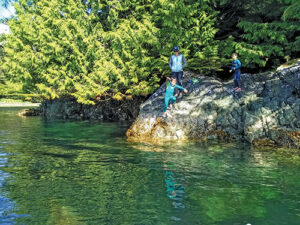
Fast forward a couple of years and, not only had our cruising grounds expanded, so, too, had our family. With our two boys, Porter and Magnus now on the crew, beach days and tide-pooling became a regularly-scheduled activity. And in the summers, we couldn’t keep them out of the water.
After spending the winter and spring in the San Juan Islands, where it was still too chilly to swim, we found ourselves in the Gulf Islands when summer officially began. We all know this feeling in the Pacific Northwest, when the first really hot days come and the water goes from a no-go zone to utterly enticing.
The big lesson that we learned throughout this summer of cruising was to time our swims with a flood tide. We realized pretty quickly that when the incoming tide flowed in over sandy or rocky beaches or shorelines that had been baking in the sun and drying out for hours, that the water warmed up quite quickly. Places like Sidney Spit, Princess Cove, and Churchill Beach near Ganges were among many saltwater soaking highlights.
One spot in particular caught our attention, though. Just off the southwest corner of Thetis Island near Telegraph Harbour is a fixed Lateral Beacon with a red light that sits atop a rocky and sandy shoal. While passing by, we noticed that, at low tide, white sand emerged, revealing a beach that is perfect for a picnic. Then, as the incoming tide covers the sand, especially on hot days, the water gets warmer and is ideal for swimming. It’s little known places like these that can make the best spots to take a dip.
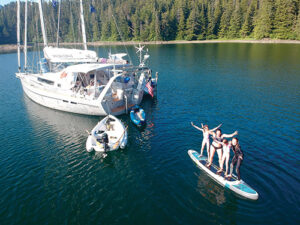
and Yahtzee had a blast in Leesoffskaia Bay near Sitka.
A few weeks after leaving the Gulf Islands, we sailed toward Desolation Sound and into what we had been told was the crown jewel of saltwater swimming in the Salish Sea. Oh boy, we were not disappointed. The Sound is known for its unusually warm water temperatures during the summer months because of the limited tidal exchange coming from the Strait of Juan de Fuca, Strait of Georgia, and Johnstone Strait. The mixing of tidal currents allows the water to warm significantly under the summer sun, resulting in temperatures that can reach up to 75° fahrenheit. That’s pretty darn warm!
Accordingly, our family spent nearly three weeks anchored in favorite swimming spots including Squirrel Cove, Von Donop Inlet, Roscoe Bay, Laura Cove, Tenedos Bay, and, of course, the infamous Prideaux Haven. Prideaux is notorious for larger power yachts posting up for days on end, partying, and swimming; and while we experienced some of that, it didn’t ruin the scene as much as we’d been told. We met up with friends there and formed a five-boat raft-up to enjoy the splendid summer weather and soak in the warm water. It’s definitely worth a stop.
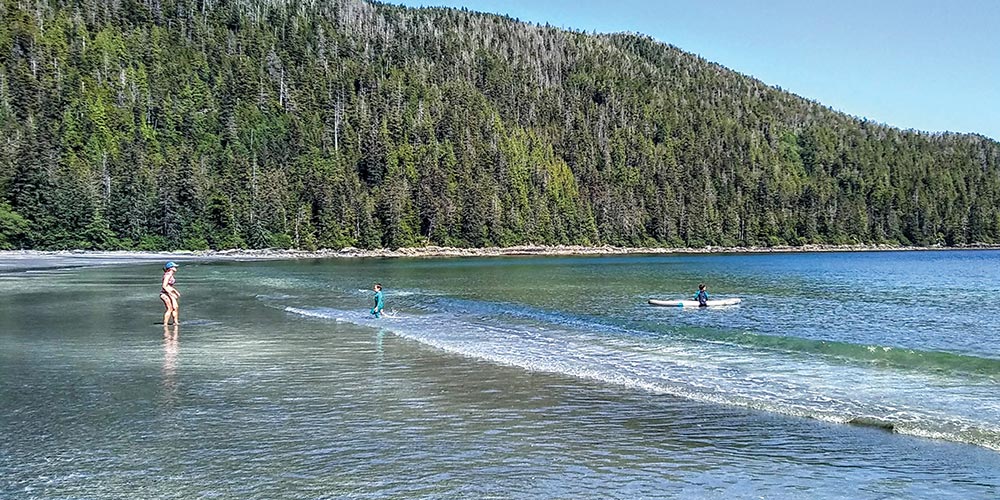
Alaska
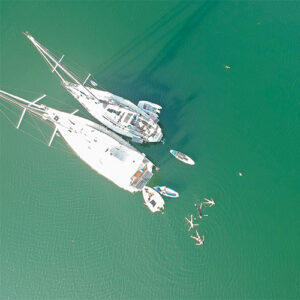
Swimming in Puget Sound and British Columbia was one thing, but when we decided to cruise north to Alaska, we didn’t expect it to continue. For the most part it didn’t, but by employing the “cold water over warm beach” method that we’d used so readily farther south, we found some amazing spots that we had all to ourselves. Also, we equipped the boys with wetsuits that allowed them to play in the water for longer periods of time without getting too cold.
Near Sitka on Baranof Island, Leesoffskaia Bay provided some of the warmest saltwater we found in Southeast Alaska. We didn’t have a temperature reading, but it must have been in the 60° range. The bay is situated in an east-west finger that has several doglegs, and is relatively shallow by Alaska standards. On a warm week in mid-July, we rafted up with our good friends on the Garcia Exploration 45, Arctic Monkey, and our boys and their three girls swam to their hearts’ content. King of the standup paddleboard was a regular game and the kids spent more time in the water than they had since Desolation Sound.
A few weeks later during an unusually stunning string of warm and dry weather, we nosed our way into Warren Cove on the eastern side of Warren Island, just west of Prince of Wales Island. We only expected to be there one night before moving on, but what we found made us stay several days. At the head of the cove is a stunning white sand beach that we played on for hours. The boys “surfed” on the standup paddleboard, and swam in their wetsuits when the tide came in and covered the beach. We only left when an overcast and cool day arrived, driving us to Craig for provisions, fuel, pizza, and ice cream.
There are quite a few islands near Craig, and a number of them have secluded anchorages that are rarely visited by cruisers. One of them had a very Desolation Sound-esque feel as we set our anchor and it offered the same sort of sun-on-rocks warmth—Cruz Pass on San Fernando Island. With wetsuits on, we kayaked and SUPed around the anchorage, finding large boulders to jump off into deep water and then swim back and do it all over again. To this day, the boys still talk about it. Though we hadn’t expected this to be part of our Alaska cruising experience, we truly made the best of it.
Cruz Bay ended up being our last swimming stop in Alaska before we set sail for San Francisco and beyond. When we arrived in the Bay Area, summer was still in full blast mode and we again took to the water. As we’d done in the Pacific Northwest and Alaska, we found some favorite spots to swim, but the vibe was different. Up north, we’d worked harder for it and most of the places where we swam were very secluded and there were few busy beaches. California was different.
I don’t know if we knew it at the time—especially while looking forward to the warmer waters of Mexico—but these Pacific Northwest saltwater swimming experiences had spoiled us. Looking back, I can honestly say that they made us more grateful for the times when the sun was hot, and an incoming tide was about to cover a beach or nearby rocky outcropping. The enthusiasm for those moments still resonates today. It’s hard to imagine what our cruising life would be like if we hadn’t made that first jump into the waters of the South Sound, but I’m sure glad we went for it. It helped us immerse ourselves fully in the cruising experience of the Pacific Northwest and fueled our dreams of wilder adventures as a family.
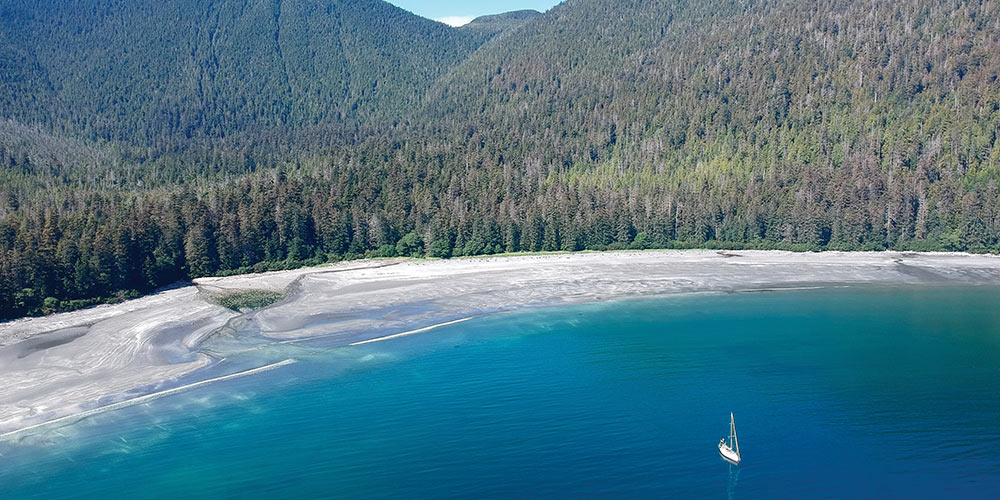
Andy Cross is the editor of 48° North. After years cruising the Pacific Northwest and Alaska with his family aboard their Grand Soleil 39, Yahtzee, they sailed south and are currently in the islands of the Eastern Caribbean.
Andy Cross
Andy Cross is the editor of 48° North. After years cruising the Pacific Northwest and Alaska with his family aboard their Grand Soleil 39, Yahtzee, they sailed south and are currently in the Caribbean Sea. You can follow their adventures at SailingYahtzee.com.
